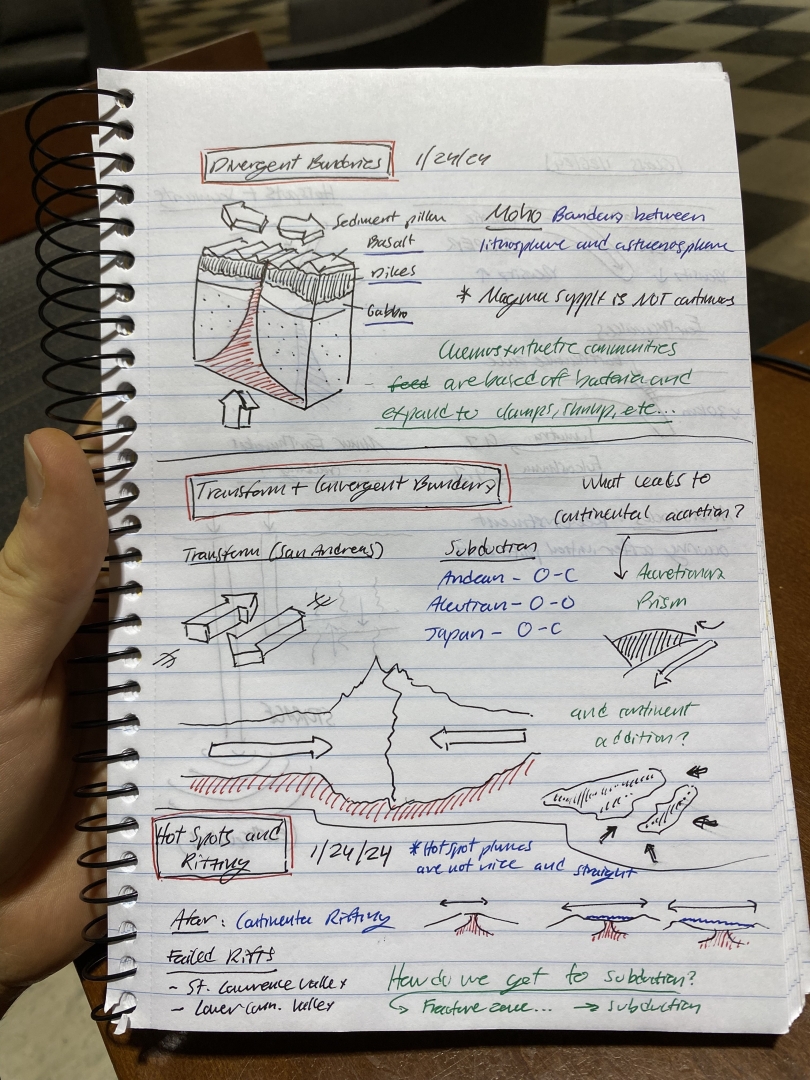

Nathan Hammerschmitt Le Gal


My Introduction to Earth Science
Lately, my brain break has taken the form of video lectures and "fun" note-taking for my Earth Science course: "The Evolution of Earth and Life." It may sound strange that I look forward to completing work for this class, but I've taken it as a good sign. I like sitting down and just having to watch someone enthusiastically present fascinating content (kudos to Prof. Osterberg) and doodling the geological or biological processes we're learning about. For any STEM course, I try to channel some creativity. I use multi-colored pens, draw visual notes, and make labeled diagrams; this ultimately makes the learning process more enjoyable and even more effective.
The course has largely strengthened my interest in Earth Science. We've covered a lot, ranging from basic petrology (mineral stuff) to biological evolution. After learning about the Upper Valley's glacial legacy, our class had an opportunity to go out into the field and observe the glacial features of the landscape. Earth science is an incredibly tangible science, yet it can be difficult to conceptualize the colossal, extremely long-term processes that characterize the field. By actually going outside and making real observations, I was able to understand classroom content in a far deeper, applicable way—I know what features of a glacial landscape look like in person.

Another feature of the course was a class discussion on a book assignment: "The Sixth Extinction." Though covering a heavy subject (the modern extinction event caused by humans), the book prompted deep discussion: Do we have a moral obligation to preserve species? Are some species more inherently valuable than others? My takeaway from the conversation was an impression of how important earth science is to our modern understanding of what is "good and bad." Earth science can teach us about our past and where we might be headed—something that makes for quite a thought-provoking exchange.
While this is my first earth science course, it's also a course that has put the department's opportunities on my radar. Beyond research opportunities, the department runs a foreign study program called "The Stretch," which brings Dartmouth students to a diverse array of geological sites around Western North America. I won't get into the details (because I haven't gone), but more information can be found here! It's essentially a field-based program that takes place across an entire term and provides class credit while doing so. Between walking on actual glaciers and descending into the Grand Canyon, the Stretch is a dream opportunity for any earth science enthusiast.
Maybe I'll blog about "The Stretch" many posts from now!
Posts You Might Like

My go-to study spots have changed a lot since I first came to Dartmouth!


Hear about the start of my sophomore year!



Read about my experience working with oral history and the digital humanities in the classroom!


Summers between terms look different for every Dartmouth student! Opportunities are abundant and it's all what you make it out to be. This summer I interned on the Clean Energy Team at Wood PLC and traveled home to see my sister get married!


Read more about the Phil 1.08 Philosophy of Time and Time Travel class!


Spending my summer off term getting my CNA license in Boston!


Ciao Bella! Let me explain how I am completing the Dartmouth language requirement one row at a time.


Read more about the Ling 1 Introductory Linguistics class!
